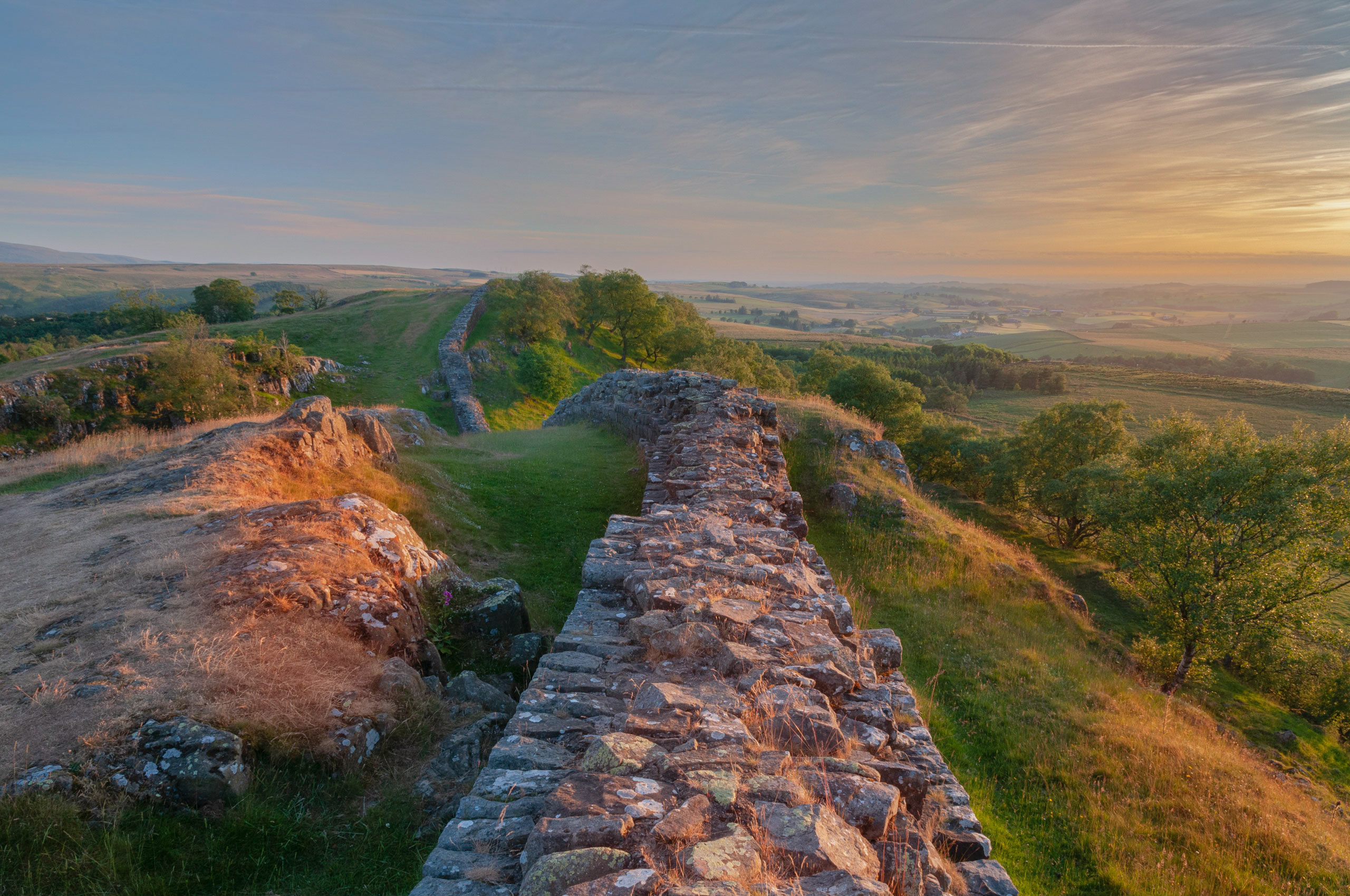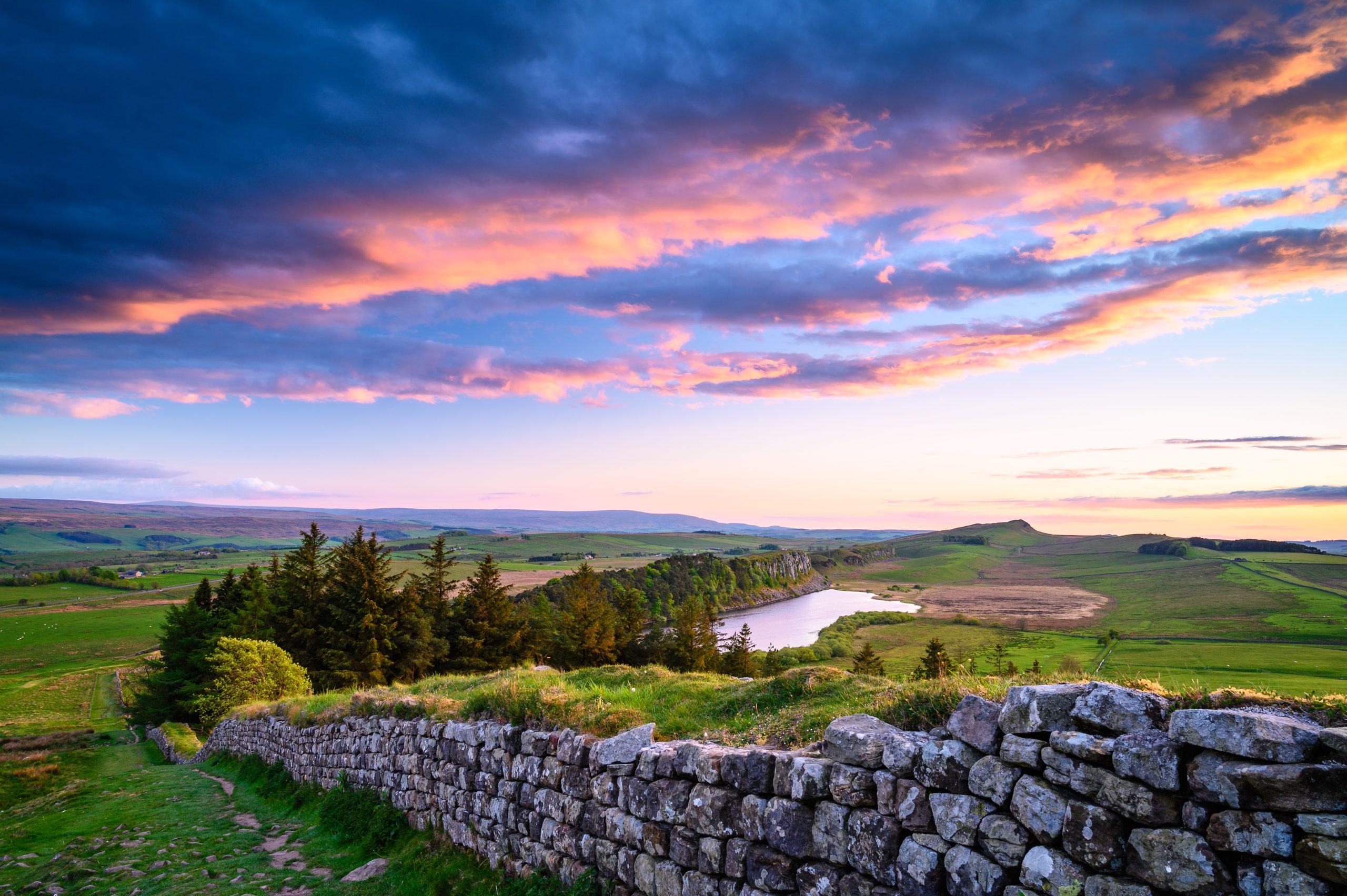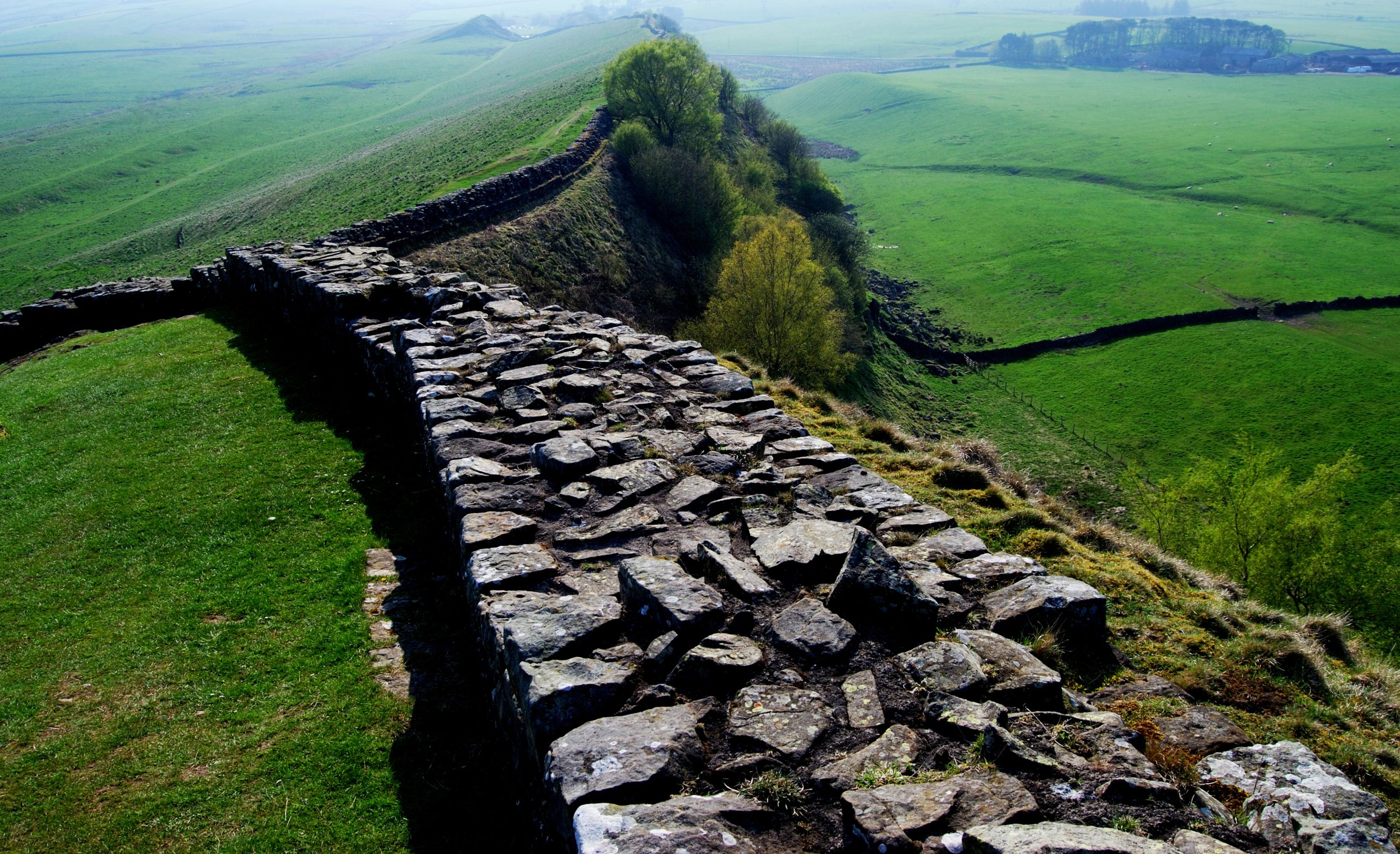Great Chesters sits in a less prominent position than the major forts, occupying gently sloping ground rather than dramatic hilltops. This lower-key location means fewer visitors, creating opportunities for peaceful exploration of well-preserved Roman remains in atmospheric surroundings.
The History
The Romans established Great Chesters around AD 128-138, after Hadrian’s Wall‘s initial construction phase. The fort housed approximately 500 soldiers, initially from the Second Cohort of Asturians, a Spanish cavalry unit. Later garrisons included the Sixth Cohort of Nervians from what is now Belgium.
The fort’s Latin name, Aesica, appears on inscribed stones found at the site. The name’s meaning remains uncertain—it might derive from a Celtic water-related term, possibly referencing the fort’s sophisticated water supply system.
Great Chesters had an unusual feature that puzzled archaeologists for years—a strong room or underground vault built beneath the headquarters building. This secure chamber might have stored military payroll, valuable equipment, or important documents. The vault’s roof construction was sophisticated, using interlocking stones that supported the weight of the building above.
The fort’s water supply demonstrated impressive Roman engineering. An aqueduct brought water from springs at Caw Burn, nearly 3 miles away. The aqueduct maintained a gentle gradient, using gravity to deliver constant water flow. Parts of the stone-lined channel survive, showing construction details.
Evidence suggests Great Chesters experienced troubles during the late 2nd century. Burnt layers in archaeological excavations indicate fire damage, possibly from attack or accident. The fort was subsequently rebuilt and remained occupied into the 4th century.
After Roman withdrawal, Great Chesters followed the typical pattern of gradual abandonment and stone robbing. Medieval builders removed useful stone, particularly the finely dressed facing blocks. What remained were mainly the less accessible foundation courses and the earthwork defenses.
Why Visit Great Chesters
Great Chesters rewards visitors seeking quieter Roman experiences away from major tourist sites. The fort combines clear archaeological remains with peaceful rural surroundings, allowing contemplative exploration.
The fort layout:
The defensive walls and internal buildings are clearly traceable:
- The headquarters building (principia) foundations show the standard layout
- The underground strong room remains accessible via stone steps
- Barrack blocks line the fort’s interior
- The commanding officer’s house occupies its traditional position
- Granaries stored food supplies for the garrison
Walking around the fort’s perimeter, you can trace the defensive walls and ditches. The earthwork ramparts survive well, creating raised walkways around the site. Standing on these banks gives you a Roman sentry’s viewpoint, looking out across the landscape they monitored.
The underground strong room:
This unusual feature is Great Chesters’ most distinctive element. Stone steps descend into the chamber, which has a corbelled roof—stones laid in progressively overlapping courses until they meet at the center. This construction technique created a self-supporting vault without requiring wooden beams.
The chamber’s purpose sparked considerable academic debate. Strong rooms for storing payroll were common in Roman forts, but underground versions were unusual. The extra security suggests this location required exceptional protection, possibly because it served multiple nearby installations.
Visiting the strong room provides a tangible connection to Roman military life. Standing in this ancient vault, you’re in a space created by Roman engineers nearly 2,000 years ago, used by soldiers whose names we’ll never know but whose work has endured through the centuries.
Hadrian’s Wall sections:
The wall runs through the fort, and sections either side show varying preservation:
- Some stretches retain multiple courses of stonework
- Foundation trenches show where facing stones were robbed
- The wall’s width and construction technique are visible
- Turret foundations appear at intervals
The wall sections near Great Chesters aren’t as spectacular as the high crags further east, but they demonstrate typical construction in less dramatic terrain. The Romans maintained consistent building standards whether on exposed hilltops or gentler slopes.
The aqueduct remains:
Parts of the Roman aqueduct are visible in the landscape, though locating them requires some searching. The stone-lined channel appears in field boundaries and farm tracks. Seeing these remains emphasizes Roman engineering sophistication—calculating gradients over several miles to deliver consistent water flow required advanced mathematical knowledge.
Information boards explain the aqueduct’s route and construction. Following its course makes an interesting walk for anyone with time and interest in Roman infrastructure.
The surrounding landscape:
Great Chesters occupies attractive countryside with views across rolling farmland. The setting is peaceful, with distant hills creating a sense of the frontier’s remoteness. Sheep graze around the fort ruins, and bird song fills the air—curlews in spring, skylarks in summer.
The quietness here contrasts sharply with busier sites like Housesteads. You might spend an hour exploring Great Chesters and encounter no other visitors. This solitude creates a more meditative experience, allowing you to absorb the atmosphere without distractions.
Time Required
Allow 60-90 minutes for thorough exploration of Great Chesters. The fort is smaller than major sites like Housesteads, but examining the buildings carefully and walking the perimeter deserves adequate time. The strong room alone warrants 15-20 minutes.
If you’re interested in following the aqueduct’s route, add another hour or more. The walk to Caw Burn springs and back makes a pleasant extension for anyone with extra time or staying locally.
Location on the Trail
Great Chesters sits directly on the Hadrian’s Wall Path, approximately 43 miles from the trail’s western end at Bowness-on-Solway. This positions it in the western half of the wall but before the final gentle sections toward the Solway.
From the west, you approach after walking through Birdoswald and the Irthing valley. The terrain here is generally easier than the high crags, though still undulating. From the east, Great Chesters comes after descending from the dramatic central section, positioned where the landscape becomes gentler.
The fort is easily accessed from the trail—the path runs directly through it. Unlike some sites requiring detours, Great Chesters doesn’t interrupt your walking rhythm. You can explore without adding significant distance to your day.
Most walking itineraries include Great Chesters as a brief stop rather than extended visit. The site’s modest size and location between major attractions means many walkers pass through fairly quickly. However, anyone interested in Roman archaeology should resist rushing—Great Chesters deserves proper attention.
Practical Tips for Walkers
Great Chesters is freely accessible with no admission charge. English Heritage manages the site, but unlike their ticketed properties, Great Chesters remains permanently open. This free access is welcome—you can visit at any time without worrying about opening hours or costs.
Facilities:
There are no facilities at Great Chesters—no toilets, no visitor center, no refreshments. The site is simply the Roman remains in a field. Plan accordingly:
- Carry sufficient water
- Bring snacks if needed
- Use facilities at previous or next stopping points
- No shelter except the stone walls themselves
The nearest facilities are at accommodation in Cawfields, Haltwhistle, or other nearby locations. Most walkers treat Great Chesters as a quick exploration stop between locations with proper facilities.
Terrain and accessibility:
The site occupies sloping farmland with grass paths throughout. The ground can be uneven and muddy after rain. Walking boots provide adequate grip in most conditions.
The strong room steps are worn stone and can be slippery. The chamber itself is small and dark—a torch (or phone light) helps you see properly. The corbelled roof is fascinating but the space is cramped and not suitable for anyone with mobility limitations.
The defensive banks around the fort provide elevated walking but have no barriers. Watch your footing, particularly if the grass is wet and slippery.
Weather considerations:
Great Chesters is moderately exposed. The site lacks the dramatic hilltop position of forts like Housesteads but still experiences typical Northumberland weather. Wind can be brisk even when valleys are calm.
The stone walls provide some wind shelter. The strong room offers complete weather protection, though it’s hardly a comfortable rest spot. In heavy rain, the site can be unpleasant for extended exploration—visibility reduces and the grass becomes slippery.
Photography:
Great Chesters photographs well in soft light—early morning or late afternoon when low sun angles emphasize the stonework and earthworks. The surrounding landscape provides attractive context for wider shots showing the fort in its setting.
The strong room is challenging to photograph due to darkness and confined space. A torch helps illuminate details, and phone cameras with night modes work reasonably well.
Timing your visit:
Most walkers pass Great Chesters mid-morning or mid-afternoon as part of walking stages. Early morning visits (if camping nearby or staying locally) provide the best light and guaranteed solitude. Evening visits work well too, particularly in summer when long daylight hours allow relaxed exploration.
The site’s free access means you can visit outside normal tourism hours—dawn visits for photographers, or evening exploration when you’ve finished your day’s walk and are staying nearby.
Combining with other sites:
Great Chesters works well combined with other nearby attractions:
- Carvoran and the Roman Army Museum (approximately 5 miles west)
- Vindolanda (approximately 6 miles east, requiring off-trail detour)
- Various turret and milecastle sites along intervening wall sections
Creating circular walks incorporating multiple sites is possible if you’re based locally. The immediate area has limited accommodation, but Haltwhistle (3 miles south) or Greenhead provide bases for day walks.
Historical context:
Reading about Great Chesters before visiting enhances appreciation. The site’s unusual features—the strong room and sophisticated aqueduct—are more interesting when you understand their significance. The Roman Army Museum at Carvoran provides relevant context about fort functions and military life.
Wildlife and nature:
The peaceful setting means wildlife is often visible. Skylarks nest in surrounding fields, and their ascending song is characteristic of summer visits. Curlews breed nearby, their liquid calls echoing across the landscape. Rabbits are common, and occasionally roe deer appear in early morning or evening.
The wildflowers in summer include meadow flowers that would have been familiar to Roman soldiers—the landscape’s fundamental character hasn’t changed despite two millennia passing. This continuity creates a connection across time that more developed sites sometimes lack.
Respect for the site:
Great Chesters’ unsupervised nature requires visitor responsibility. Don’t climb on walls, remove stones, or cause damage. The site survives because people respect it—your careful behavior helps preserve these remains for future visitors.
Stay on paths through surrounding farmland. The fort sits within working agricultural land, and farmers allow access across their property. Respecting their livelihood ensures continued access for walkers.
Value for walkers:
Great Chesters might seem minor compared to spectacular sites like Vindolanda or Housesteads. However, its very ordinariness is valuable—this represents a typical Roman fort, the standard installation repeated along the wall. Understanding the typical enhances appreciation of the exceptional.
For walkers covering the full trail, Great Chesters provides pleasant variety between major sites. The brief exploration break rests your legs whilst offering archaeological interest. These smaller sites collectively contribute to understanding the wall as a complex military system rather than isolated forts.





